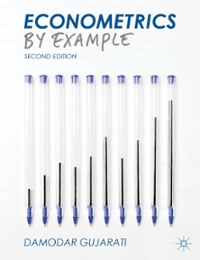Question
complete question There are two types of consumers: one half of consumers are type 1 (low type) and the other half are type 2 (high
complete question
There are two types of consumers: one half of consumers are type 1 (low type) and the other half are type 2 (high type). Type 1's demand curve is q1 = 4 P, while type 2's demand is given by q2 = 6 P. Consider a monopolist selling its product to these consumers. Assume that the marginal cost is equal to zero.
However, the firm does not know an individual consumer's type. It only knows that there are two types of consumers with demand curves given as above. Suppose that the firm can offer only a single two-part tariff, (T,P), where T is the lump-sum fee and P is the unit price.
(1) If the firm serves only high type consumers, what should be the optimal two-part tariff, T and P ? Also, compute the resulting profit.
(2) If the firm serves both types of consumers, what is the firm's profit when it offers (T,P)? Find the expression in terms of P only.
(3) Compute P that maximizes the firm's profit in (2). Also, compute the optimal T, as well as the resulting profit.
(4) Compare the profit from (1) and the profit from (3), and determine which two-part tariff will be chosen by the firm. Also, compute the social surplus from the two-part tariff chosen by the firm.
The demand for sugar is: Q = 20 - P The supply of sugar is: Q = 2 + P Quantities are in million hundredweight (cwt.) and price is dollars per cwt. Please graph on graph paper the following problems. Label all axes, lines, and equilibrium values 1. What is the equilibrium price and quantity of sugar in the absence of any agricultural policy? 2. If the government establishes a support price for sugar of $12 per cwt. (hundred pounds) and is willing to buy up any surplus sugar at that price, indicate on your graph the quantity supplied, quantity demanded, and quantity purchased by the government. If the units are million cwt., how much money is required for the government purchases? Show this amount on your graph. 3. The government decides that the sugar price support program is getting too expensive. It abandons the support-price program and instead assigns a marketing quota to each sugar producer. This quota gives the holder the right to sell sugar on the market and can be transferred to other producers. Altogether the quotas allocated to sugar growers add up to 9 million cwt. Please graph this problem, indicating clearly the market price and quantity. 4. If there is a free market for renting quota, what is the maximum the quota should rent for per cwt? If a farmer with marginal production costs of $6 per cwt. owned quota, would it be more profitable for her/him to produce the sugar or to rent the quota to someone else? Please explain.
Assume, that the demand for the Giants game is Q = 80,000-400P.
a) Assume the stadium capacity of 30,000. What is the monopolistic outcome (price and quantity)? Marginal revenue: MR = 200 - Q/200. Please demonstrate on the graph.
b) What is the perfectly competitive outcome (price and quantity)? What are the dead weight losses generated by the monopoly in part a?
c) Assume, that the team moved to a bigger stadium with the capacity 50,000 spectators (the demand remains the same). Find the monopolistic outcome (price and quantity) and the dead weight losses.
Step by Step Solution
There are 3 Steps involved in it
Step: 1

Get Instant Access to Expert-Tailored Solutions
See step-by-step solutions with expert insights and AI powered tools for academic success
Step: 2

Step: 3

Ace Your Homework with AI
Get the answers you need in no time with our AI-driven, step-by-step assistance
Get Started


